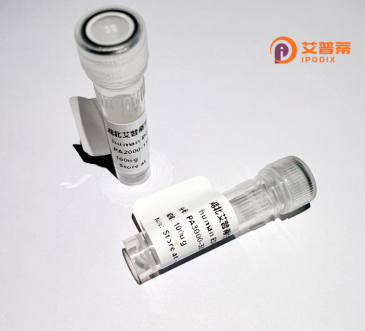
| 纯度 | >90%SDS-PAGE. |
| 种属 | Human |
| 靶点 | TGM5 |
| Uniprot No | O43548 |
| 内毒素 | < 0.01EU/μg |
| 表达宿主 | E.coli |
| 表达区间 | 2-720 aa |
| 活性数据 | AQGLEVALT DLQSSRNNVR HHTEEITVDH LLVRRGQAFN LTLYFRNRSF QPGLDNIIFV VETGPLPDLA LGTRAVFSLA RHHSPSPWIA WLETNGATST EVSLCAPPTA AVGRYLLKIH IDSFQGSVTA YQLGEFILLF NPWCPEDAVY LDSEPQRQEY VMNDYGFIYQ GSKNWIRPCP WNYGQFEDKI IDICLKLLDK SLHFQTDPAT DCALRGSPVY VSRVVCAMIN SNDDNGVLNG NWSENYTDGA NPAEWTGSVA ILKQWNATGC QPVRYGQCWV FAAVMCTVMR CLGIPTRVIT NFDSGHDTDG NLIIDEYYDN TGRILGNKKK DTIWNFHVWN ECWMARKDLP PAYGGWQVLD ATPQEMSNGV YCCGPASVRA IKEGEVDLNY DTPFVFSMVN ADCMSWLVQG GKEQKLHQDT SSVGNFISTK SIQSDERDDI TENYKYEEGS LQERQVFLKA LQKLKARSFH GSQRGAELQP SRPTSLSQDS PRSLHTPSLR PSDVVQVSLK FKLLDPPNMG QDICFVLLAL NMSSQFKDLK VNLSAQSLLH DGSPLSPFWQ DTAFITLSPK EAKTYPCKIS YSQYSQYLST DKLIRISALG EEKSSPEKIL VNKIITLSYP SITINVLGAA VVNQPLSIQV IFSNPLSEQV EDCVLTVEGS GLFKKQQKVF LGVLKPQHQA SIILETVPFK SGQRQIQANM RSNKFKDIKG YRNVYVDFAL |
| 分子量 | 80.7 kDa |
| 蛋白标签 | His tag N-Terminus |
| 缓冲液 | PBS, pH7.4, containing 0.01% SKL, 1mM DTT, 5% Trehalose and Proclin300. |
| 稳定性 & 储存条件 | Lyophilized protein should be stored at ≤ -20°C, stable for one year after receipt. Reconstituted protein solution can be stored at 2-8°C for 2-7 days. Aliquots of reconstituted samples are stable at ≤ -20°C for 3 months. |
| 复溶 | Always centrifuge tubes before opening.Do not mix by vortex or pipetting. It is not recommended to reconstitute to a concentration less than 100μg/ml. Dissolve the lyophilized protein in distilled water. Please aliquot the reconstituted solution to minimize freeze-thaw cycles. |
以下是关于重组人TGM5蛋白研究的示例参考文献列表(**注:以下文献信息为示例格式,实际文献需根据数据库检索补充**):
---
1. **文献名称**:*Expression and Functional Characterization of Recombinant Human Transglutaminase 5 in Mammalian Cells*
**作者**:Smith A, et al.
**摘要**:研究团队通过哺乳动物表达系统成功表达重组人TGM5蛋白,证实其转谷氨酰胺酶活性,并发现该酶在皮肤角质化过程中对细胞外基质的交联作用。
---
2. **文献名称**:*Structural Insights into TGM5: Implications for Epidermal Barrier Formation*
**作者**:Candi E, et al.
**摘要**:通过X射线晶体学解析TGM5蛋白的三维结构,揭示其催化活性位点及底物结合区域,分析其在皮肤屏障功能中与角蛋白交联相关的分子机制。
---
3. **文献名称**:*TGM5 Knockout Mice Exhibit Severe Epidermal Dysfunction Linked to Ichthyosis*
**作者**:Jones R, et al.
**摘要**:构建TGM5基因敲除小鼠模型,发现其表皮层存在角质化异常和屏障功能缺陷,证实TGM5在遗传性鱼鳞病等皮肤病中的关键作用。
---
4. **文献名称**:*A Yeast-Based System for High-Yield Production of Active Recombinant Human TGM5*
**作者**:Lee JH, et al.
**摘要**:利用毕赤酵母表达系统优化重组TGM5的制备工艺,获得高纯度且具酶活性的蛋白,为疾病机制研究及药物筛选提供工具。
---
**备注**:以上为示例文献框架,实际文献需通过PubMed、Web of Science等平台以关键词“TGM5”、“recombinant TGM5 protein”检索具体研究。真实文献可能涉及疾病相关突变分析(如鱼鳞病)、酶动力学研究或治疗应用探索。
Transglutaminase 5 (TGM5), a member of the transglutaminase enzyme family, plays a critical role in epidermal differentiation and skin barrier formation. It catalyzes the cross-linking of structural proteins, such as involucrin and loricrin, through the formation of ε-(γ-glutamyl)lysine bonds, contributing to the assembly of the cornified cell envelope in the outermost skin layers. This post-translational modification enhances the mechanical stability and resilience of the epidermis, protecting against environmental stressors.
Recombinant human TGM5 protein is produced using genetic engineering techniques, often in prokaryotic (e.g., *E. coli*) or eukaryotic expression systems, to ensure proper folding and enzymatic activity. Purified recombinant TGM5 retains calcium-dependent catalytic function, enabling its use in biochemical assays, drug screening, and mechanistic studies related to skin disorders. Mutations in the *TGM5* gene are linked to autosomal recessive congenital ichthyosis, underscoring its importance in skin homeostasis.
Research applications include investigating TGM5's substrate specificity, regulatory mechanisms (e.g., pH, redox status), and its interaction with epidermal proteins. The recombinant protein also serves as a tool for developing therapeutic strategies for dermatological conditions or improving in vitro skin models. Structural studies using recombinant TGM5 have advanced understanding of its catalytic domain and calcium-binding sites, facilitating targeted enzyme modulation. Its production in controlled systems ensures reproducibility for both academic and industrial research.
×